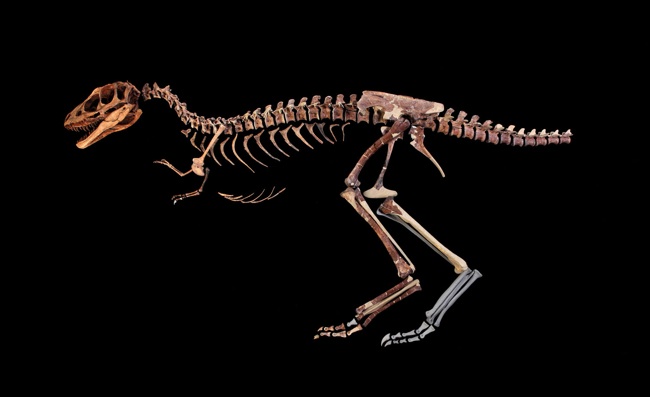Man-Sized Dinosaur Was a Tiny T. Rex

A miniature Tyrannosaurus rex of sorts that walked the Earth 125 million years ago may have been tiny but was equipped with all of the fierce features of its infamous descendant.
While the newly discovered dinosaur was not a T. rex, it was a tyrannosaurid species related to T. rex that lived tens of millions of years earlier than its mighty cousin. And it's a nearly exact scaled-down version of the larger paleo-beast, according to an examination of the dinosaur remains unearthed in northeast China.
"It [scales] like nothing we've ever seen before," said study scientist Paul Sereno of the University of Chicago.
Until now, scientists had thought T. rex and its oversized kin evolved predatory adaptations — such as a large head and puny arms — as a result of, or perhaps in tandem with, their large size. The new finding, however, suggests a T. rex blueprint for taking down prey evolved, and was successful, in the pint-size, well before the giant tyrannosaurs emerged.
Weighing in at a measly 150 pounds with a body length of just 9 feet (2.7 m), the newly discovered dinosaur, Raptorex kriegsteini, was 100 times smaller than T. rex, said Sereno, who along with his colleagues details the finding on Sept. 17 in Science Express, the online edition of the journal Science.
Raptorex shows that tyrannosaur design evolved at "punk size," Sereno said, "basically our bodyweight. And that's pretty staggering, because there's no other example that I can think of where an animal has been so finely designed at about 100th the size that it would eventually become."
Even at such a diminutive size, Raptorex would have been just as savvy a killing machine as the later T. rex. "I would suspect that the common parrot-beaked dinosaurs (Psittacosaurus) were often dinner," Sereno said.
Sign up for the Live Science daily newsletter now
Get the world’s most fascinating discoveries delivered straight to your inbox.
Its meat-eating prowess can be attributed to a scaled-down version of just about all of the predatory traits found in T. rex, the researchers say. Specifically, the researchers found that Raptorex was equipped with tiny forelimbs, long legs for quick running, powerful jaw muscles, an oversized head relative to its torso, and enlarged olfactory bulbs suggesting an expert sense of smell — all hallmarks of its overgrown progeny.
"Many of these traits have never been seen in anything but the big brutes," Sereno said. "That's what's so surprising about the whole thing, from tooth to limbs to even the space for the brain, we see things we used to think were just exclusive to the big tyrannosaurids in the late Cretaceous. But there they are."
From the fossil record, scientists know that other primitive tyrannosaurs with small bodies existed millions of years before T. rex. But their similarities to later tyrannosaurs were often limited, and might include only a similar tooth feature or hip bone, Sereno said.
"There were many intermediate species," Sereno said. "However, Raptorex is about as close as we may ever come to a direct ancestor of all of the later big guys and gals we call tyrannosaurids, including T. rex."
Xu Xing of the Institute of Vertebrate Paleontology and Paleoanthropology in China, who was not involved in the discovery, said the finding suggests typical tyrannosaurid features evolved much earlier than previously thought.
"You would not be surprised to see a large tyrannosaurid with a huge skull and tiny forelimbs, but it is amazing that you see these features in a relatively small animal when other similarly-sized, closely related species are more like other theropods in having a smaller skull and larger arms," Xu told LiveScience.
The work was funded by the Whitten-Newman Foundation and the National Geographic Society.
- A Brief History of Dinosaurs
- Avian Ancestors: Dinosaurs That Learned to Fly
- Images: Dinosaur Fossils
Jeanna Bryner is managing editor of Scientific American. Previously she was editor in chief of Live Science and, prior to that, an editor at Scholastic's Science World magazine. Bryner has an English degree from Salisbury University, a master's degree in biogeochemistry and environmental sciences from the University of Maryland and a graduate science journalism degree from New York University. She has worked as a biologist in Florida, where she monitored wetlands and did field surveys for endangered species, including the gorgeous Florida Scrub Jay. She also received an ocean sciences journalism fellowship from the Woods Hole Oceanographic Institution. She is a firm believer that science is for everyone and that just about everything can be viewed through the lens of science.









